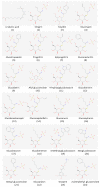Glucosinolates and Omega-3 Fatty Acids from Mustard Seeds: Phytochemistry and Pharmacology
- PMID: 36079672
- PMCID: PMC9459965
- DOI: 10.3390/plants11172290
Glucosinolates and Omega-3 Fatty Acids from Mustard Seeds: Phytochemistry and Pharmacology
Abstract
Seeds from mustard (genera Brassica spp. and Sinapsis spp.), are known as a rich source of glucosinolates and omega-3 fatty acids. These compounds are widely known for their health benefits that include reducing inflammation and lowering the risk of cardiovascular diseases and cancer. This review presented a synthesis of published literature from Google Scholar, PubMed, Scopus, Sci Finder, and Web of Science regarding the different glucosinolates and omega-3 fatty acids isolated from mustard seeds. We presented an overview of extraction, isolation, purification, and structure elucidation of glucosinolates from the seeds of mustard plants. Moreover, we presented a compilation of in vitro, in vivo, and clinical studies showing the potential health benefits of glucosinolates and omega-3 fatty acids. Previous studies showed that glucosinolates have antimicrobial, antipain, and anticancer properties while omega-3 fatty acids are useful for their pharmacologic effects against sleep disorders, anxiety, cerebrovascular disease, neurodegenerative disease, hypercholesterolemia, and diabetes. Further studies are needed to investigate other naturally occurring glucosinolates and omega-3 fatty acids, improve and standardize the extraction and isolation methods from mustard seeds, and obtain more clinical evidence on the pharmacological applications of glucosinolates and omega-3 fatty acids from mustard seeds.
Keywords: Brassica spp.; Sinapsis spp.; glucosinolates; omega-3 fatty acids; pharmaceutical properties.
Conflict of interest statement
The authors declare no conflict of interest.
Figures



Similar articles
-
Use of anion-exchange membrane extraction for the high-performance liquid chromatographic analysis of mustard seed glucosinolates.J Agric Food Chem. 2000 Nov;48(11):5190-4. doi: 10.1021/jf0003000. J Agric Food Chem. 2000. PMID: 11087457
-
Traditional uses, phytochemistry, transformation of ingredients and pharmacology of the dried seeds of Raphanus sativus L. (Raphani Semen), A comprehensive review.J Ethnopharmacol. 2022 Aug 10;294:115387. doi: 10.1016/j.jep.2022.115387. Epub 2022 May 14. J Ethnopharmacol. 2022. PMID: 35580770 Review.
-
Consumer acceptability and sensory profile of cooked broccoli with mustard seeds added to improve chemoprotective properties.J Food Sci. 2014 Sep;79(9):S1756-62. doi: 10.1111/1750-3841.12556. Epub 2014 Aug 25. J Food Sci. 2014. PMID: 25156799
-
Sulforaphane-enriched extracts from glucoraphanin-rich broccoli exert antimicrobial activity against gut pathogens in vitro and innovative cooking methods increase in vivo intestinal delivery of sulforaphane.Eur J Nutr. 2021 Apr;60(3):1263-1276. doi: 10.1007/s00394-020-02322-0. Epub 2020 Jul 10. Eur J Nutr. 2021. PMID: 32651764 Free PMC article.
-
Biologically Active Compounds in Mustard Seeds: A Toxicological Perspective.Foods. 2021 Sep 3;10(9):2089. doi: 10.3390/foods10092089. Foods. 2021. PMID: 34574199 Free PMC article. Review.
Cited by
-
Phytochemical analysis and biological study on Sinapis alba L. seeds extract incorporated with metal nanoparticles, in vitro approach.Sci Rep. 2025 Apr 21;15(1):13782. doi: 10.1038/s41598-025-95347-6. Sci Rep. 2025. PMID: 40258907 Free PMC article.
-
The effect of nitrogen management on seed yield and quality in traditional and canola-quality white mustard.Sci Rep. 2024 Oct 30;14(1):26127. doi: 10.1038/s41598-024-76582-9. Sci Rep. 2024. PMID: 39477998 Free PMC article.
-
Next generation plant biostimulants & genome sequencing strategies for sustainable agriculture development.Front Microbiol. 2024 Jul 17;15:1439561. doi: 10.3389/fmicb.2024.1439561. eCollection 2024. Front Microbiol. 2024. PMID: 39104588 Free PMC article. Review.
-
Chemical Profile and Biological Activities of Brassica rapa and Brassica napus Ex Situ Collection from Portugal.Foods. 2024 Apr 11;13(8):1164. doi: 10.3390/foods13081164. Foods. 2024. PMID: 38672837 Free PMC article.
-
Bioactive compounds in Raphanus sativus: mechanisms of apoptosis, anti-angiogenesis, cell cycle arrest and beyond in cancer prevention and treatment.Med Oncol. 2025 Jul 13;42(8):328. doi: 10.1007/s12032-025-02894-z. Med Oncol. 2025. PMID: 40652415 Review.
References
-
- Divakaran M., Babu K.N. Mustard. In: Caballero B., Finglas P.M., Toldrá F., editors. Encyclopedia of Food and Health. Academic Press; Oxford, UK: 2016. pp. 9–19.
-
- Ladak Z., Khairy M., Armstrong E.A., Yager J.Y. Chapter 11-Glucosinolates: Paradoxically beneficial in fighting both brain cell death and cancer. In: Ghosh D., editor. Nutraceuticals in Brain Health and Beyond. Academic Press; Cambridge, MA, USA: 2021. pp. 155–167.
Publication types
Grants and funding
LinkOut - more resources
Full Text Sources
Molecular Biology Databases
Miscellaneous

